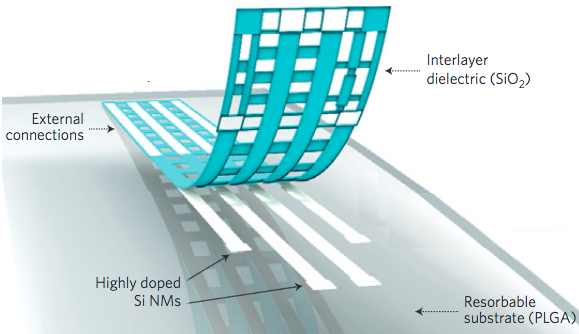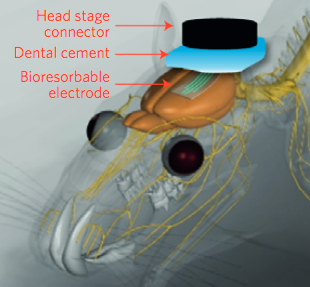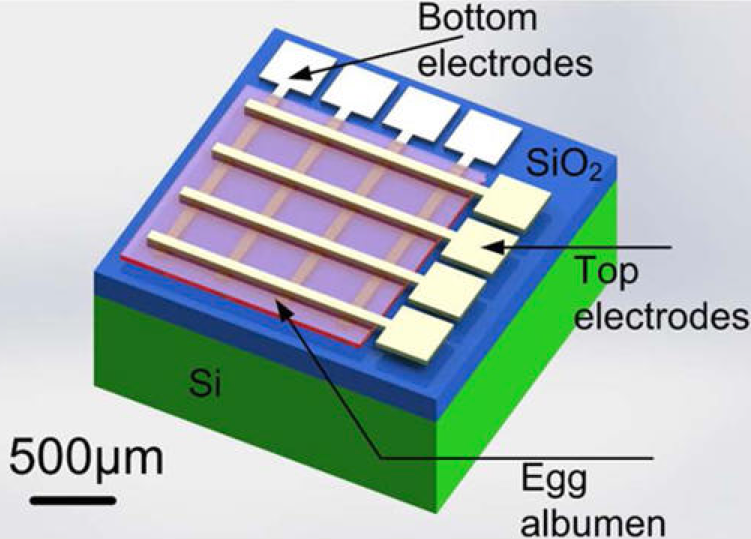Electronic devices that melt in your brain
May 6, 2016

Illustration of the construction of a bioresorbable neural electrode array for ECoG and subdermal EEG measurements. A photolithographically patterned, n-doped silicon nanomaterial (300 nm thick) is used for electrodes and interconnects. A 100 nm thick film of silicon dioxide and a foil of PLGA (30 nm thick) serve as a bioresorbable encapsulating layer and substrate, respectively. The device connects to an external data acquisition system through a conductive film interfaced to the Si nm interconnects at contact pads at the edge. (credit: Ki Jun Yu et al./Nature Materials))
Two implantable devices developed by American and Chinese researchers are designed to dissolve in the brain over time and may eliminate several current problems with implants.
University of Pennsylvania researchers have developed an electrode and an electrode array, both made of layers of silicon and molybdenum that can measure physiological characteristics (like neuron signals) and dissolve at a known rate (determined by the material’s thickness). The team used the device in anesthetized rats to record brain waves (EEGs) and induced epileptic spikes in intact live tissue.
In another experiment, they showed the dissolvable electronics could be used in a complex, multiplexed ECoG (intracranial electroencephalography) array over a 30-day period.

Cartoon illustration of a four-channel bioresorbable electrode array implanted on the left hemisphere of the brain of a rat for chronic recordings. A flexible cable connects the array to a custom-built circular interface board fixed to the skull using dental cement. (credit: Ki Jun Yu et al./Nature Materials)
As the researchers note online in Nature Materials, this new technology offers equal or greater resolution for measuring the brain’s electrical activity, compared to conventional electrodes, while eliminating “the risks, cost, and discomfort associated with surgery to extract current devices used for post-operative monitoring,” according to senior co-author Brian Litt, MD, a professor of Neurology, Neurosurgery, and Bioengineering at the Perelman School of Medicine.
Other potential uses of the dissolvable electronics include:
- Disorders such as epilepsy, Parkinson’s disease, depression, chronic pain, and conditions of the peripheral nervous system. “These measurements are critically important for mapping and monitoring brain function during and in preparation for neurosurgery, for assisting in device placement, such as for Parkinson’s disease, and for guiding surgical procedures on complex, interconnected nerve structures,” Litt said.
- Post-operative monitoring and recording of physiological characteristic after minimally invasive placement of vascular, cardiac, orthopaedic, neural or other devices. At present, post-operative monitoring is based on clinical examination or interventional radiology, which is invasive, expensive, and impractical for continuous monitoring over days to months.
- Heart and brain surgery for applications such as aneurysm coiling, stent placement, embolization, and endoscopic operations. These new devices could also monitor structures that are exposed during surgery, but are too delicate to disturb later by removing devices.
- More complex devices that also include flow, pressure, and other measurement capabilities.
The research was funded by the Defense Advanced Research Projects Agency, the Penn Medicine Neuroscience Center, a T32- Brain Injury Research Training Grant, the Mirowski Family Foundation, and by Neil and Barbara Smit.
A bioresorbable memristor

A 3D schematic drawing of cross-bar memristors on a silicon wafer made with dissolvable materials. (credit: Xingli He et al./Applied Materials & Interfaces)
In related research, Chinese researchers have developed a memristor (memory resistor) with biodissolvable components, using a 30 nm film of egg albumin protein on a silicon film substrate and electrodes made out of magnesium and tungsten.*
Testing showed that the device’s bipolar switching performance was comparable to oxide-based memristors, with a high-to-low resistance ratio in the range of 100 to 10,000. The device can store information for more than 10,000 seconds without any deterioration, showing its high stability and reliability.
Under dry conditions in the lab, the components worked reliably for more than three months. In water, the electrodes and albumin dissolved in two to 10 hours in the lab. The rest of the chip took about three days to break down, leaving minimal residues behind, the researchers report in the journal ACS Applied Materials & Interfaces.
The research was funded by the National Natural Science Foundation of China and the Research Fund for the Doctoral Program of Higher Education of China.
* Memristors may have future applications in nanoelectronic memories, computer logic, and neuromorphic/neuromemristive computer architectures. As shown in the following illustration, redox (oxidation and reduction) of iron molecules in albumen are primarily responsible for this memristor’s switching behavior. However, both Mg and W electrodes can dissolve in water easily and were shown to diffuse into the albumen film, where they also contribute to the formation of conductive filaments through redox reactions.

Schematic of the four switching processes for an albumen-based memristor, showing initial state of a memristor with Mg and W as the top and bottom electrode, respectively. (i) The colored spheres represent different ions. (ii) When a positive voltage is applied to the top electrode, ions move along the electric field, and accumulate locally in strong field regions in the albumen layer; meanwhile, injected electrons from the bottom electrode reduce metallic ions such as Fe3+ and Mg2+ to metal elements. (iii) At a specific voltage, the filaments are formed to connect the top and bottom electrodes electrically, and the device is turned on (the low resistance state). (iv) When applying a reset voltage, the conductive filaments are broken due to the oxidation of the metal elements by the injected electrons from the top electrode, the filaments are ruptured near the top electrode, and the device returns to the high-resistance state. (credit: Xingli He et al./Applied Materials & Interfaces)
Abstract of Bioresorbable silicon electronics for transient spatiotemporal mapping of electrical activity from the cerebral cortex
Bioresorbable silicon electronics technology offers unprecedented opportunities to deploy advanced implantable monitoring systems that eliminate risks, cost and discomfort associated with surgical extraction. Applications include postoperative monitoring and transient physiologic recording after percutaneous or minimally invasive placement of vascular, cardiac, orthopaedic, neural or other devices. We present an embodiment of these materials in both passive and actively addressed arrays of bioresorbable silicon electrodes with multiplexing capabilities, which record in vivo electrophysiological signals from the cortical surface and the subgaleal space. The devices detect normal physiologic and epileptiform activity, both in acute and chronic recordings. Comparative studies show sensor performance comparable to standard clinical systems and reduced tissue reactivity relative to conventional clinical electrocorticography (ECoG) electrodes. This technology offers general applicability in neural interfaces, with additional potential utility in treatment of disorders where transient monitoring and modulation of physiologic function, implant integrity and tissue recovery or regeneration are required.
Abstract of Transient Resistive Switching Devices Made from Egg Albumen Dielectrics and Dissolvable Electrodes
Egg albumen as the dielectric, and dissolvable Mg and W as the top and bottom electrodes are used to fabricate water-soluble memristors. 4 × 4 cross-bar configuration memristor devices show a bipolar resistive switching behavior with a high to low resistance ratio in the range of 1 × 102 to 1 × 104, higher than most other biomaterial-based memristors, and a retention time over 104 s without any sign of deterioration, demonstrating its high stability and reliability. Metal filaments accompanied by hopping conduction are believed to be responsible for the switching behavior of the memory devices. The Mg and W electrodes, and albumen film all can be dissolved in water within 72 h, showing their transient characteristics. This work demonstrates a new way to fabricate biocompatible and dissolvable electronic devices by using cheap, abundant, and 100% natural materials for the forthcoming bioelectronics era as well as for environmental sensors when the Internet of things takes off.